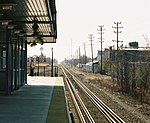Union Watersphere

The Union Watersphere, also known as the Union Water Tower, is a water tower topped with a sphere-shaped water tank in Union, New Jersey, United States and characterized as the World's Tallest Water Sphere.Adjacent to U.S. Route 22, New Jersey Route 82, and the Garden State Parkway, the iconic tower has been a landmark since its construction. The tower was originally commissioned the Elizabethtown Water Company and is now owned by American Water. Standing 212 ft (65 m) tall, it was originally built in 1964 by Chicago Bridge and Iron Company at the cost of $89,500 and holds 250,000 US gallons (950 m3) of well water. Due to its proximity to an airport, at the request of the Federal Aviation Administration, a red stroboscopic beacon was constructed atop the tower in 2008, adding 6 ft (1.8 m) of height. The pedestal is used as a telecommunications tower.The tower is a grey-white, and in the past has been painted blue, with the name of the town in large letters across the sphere. Its location at a major intersection of some of the state's busiest roads, and proximity to Newark Liberty International Airport, affords millions of people each year a view of the structure. A museum dedicated to the watersphere is located in Austin, Texas and is operated by a former Union resident. Another famous sphere, sometimes called the "world's largest light bulb" is located nearby at the Edison Memorial Tower.
Excerpt from the Wikipedia article Union Watersphere (License: CC BY-SA 3.0, Authors, Images).Union Watersphere
US 22,
Geographical coordinates (GPS) Address Nearby Places Show on map
Geographical coordinates (GPS)
| Latitude | Longitude |
|---|---|
| N 40.693274 ° | E -74.262046 ° |
Address
US 22
07083
New Jersey, United States
Open on Google Maps



